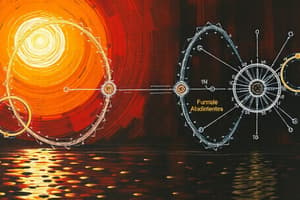Podcast
Questions and Answers
What does the Aufbau Principle state regarding electron configurations?
What does the Aufbau Principle state regarding electron configurations?
- Electrons must fill all orbitals before pairing.
- Electrons occupy the lowest energy orbitals first. (correct)
- Electrons can share the same quantum numbers.
- Electrons will occupy the highest energy orbitals first.
Which orbital filling order is correct according to the principles of electronic configuration?
Which orbital filling order is correct according to the principles of electronic configuration?
- 4p, 3s, 5s, 2s
- 3p, 2s, 1s, 4s
- 1s, 2s, 2p, 3s (correct)
- 1s, 3d, 2p, 4p
How do Hund's Rule and the Pauli Exclusion Principle differ?
How do Hund's Rule and the Pauli Exclusion Principle differ?
- Pauli Exclusion Principle is concerned with atomic orbitals and Hund's Rule is about physical energy levels.
- Both rules govern electron pairing in orbitals with the same energy.
- Hund's Rule allows pairing before filling, while Pauli prohibits identical quantum numbers.
- Hund's Rule states that electrons will fill degenerate orbitals singly before pairing, while Pauli states no two electrons can have the same quantum numbers. (correct)
What is represented by the magnetic quantum number (m_l)?
What is represented by the magnetic quantum number (m_l)?
Which statement about valence electrons is true?
Which statement about valence electrons is true?
Flashcards
Electronic Configuration
Electronic Configuration
The arrangement of electrons in an atom's orbitals.
Aufbau Principle
Aufbau Principle
Electrons fill the lowest energy orbitals first.
Pauli Exclusion Principle
Pauli Exclusion Principle
No two electrons can have the same four quantum numbers.
Hund's Rule
Hund's Rule
Signup and view all the flashcards
Valence Electrons
Valence Electrons
Signup and view all the flashcards
Study Notes
Electronic Configuration of Atoms
-
Definition: The distribution of electrons in an atom's orbitals which influences its chemical properties.
-
Principles:
- Aufbau Principle: Electrons occupy the lowest energy orbitals first.
- Pauli Exclusion Principle: No two electrons in an atom can have the same set of quantum numbers.
- Hund's Rule: Electrons will fill degenerate orbitals singly before pairing up.
-
Quantum Numbers:
- Principal quantum number (n): Indicates the energy level and size of the orbital.
- Azimuthal quantum number (l): Describes the shape of the orbital (0 = s, 1 = p, 2 = d, 3 = f).
- Magnetic quantum number (m_l): Specifies the orientation of the orbital.
- Spin quantum number (m_s): Represents the spin of the electron (+1/2 or -1/2).
-
Notation:
- Written in the form of energy levels and subshells (e.g., 1s² 2s² 2p⁶).
-
Order of Filling:
- The general order is based on the increasing energy levels:
- 1s
- 2s
- 2p
- 3s
- 3p
- 4s
- 3d
- 4p
- 5s
- 4d
- 5p
- 6s
- 4f
- 5d
- 6p
- 7s
- 5f
- 6d
- 7p
- The general order is based on the increasing energy levels:
-
Examples:
- Hydrogen (H): 1s¹
- Helium (He): 1s²
- Carbon (C): 1s² 2s² 2p²
- Iron (Fe): [Ar] 4s² 3d⁶
-
Transition Metals:
- Often exhibit variable oxidation states due to the involvement of d-orbitals in bonding.
-
Valence Electrons:
- Electrons in the outermost shell (highest n value) determine an atom's reactivity.
-
Exceptions:
- Certain configurations (like Cr and Cu) show irregularities to achieve more stable structures (e.g., 3d⁵ or 3d¹⁰).
-
Importance:
- Understanding electronic configuration helps predict chemical behavior, bonding, and reactivity of elements.
Electronic Configuration of Atoms
- Definition: The arrangement of electrons in an atom's orbitals, which directly influences its chemical behavior.
- Principles:
- Aufbau Principle: Electrons occupy the lowest energy orbitals first.
- Pauli Exclusion Principle: No two electrons in an atom can have the same set of quantum numbers.
- Hund's Rule: Electrons will fill degenerate orbitals singly before pairing up.
- Quantum Numbers:
- Principal quantum number (n): Indicates the energy level and size of the orbital (n = 1, 2, 3, etc.).
- Azimuthal quantum number (l): Describes the shape of the orbital (l = 0 (s), 1 (p), 2 (d), 3 (f)).
- Magnetic quantum number (m_l): Specifies the orientation of the orbital within a subshell (m_l = -l to +l, including 0).
- Spin quantum number (m_s): Represents the intrinsic angular momentum of an electron, which is quantized and can have a value of +1/2 or -1/2.
- Notation: Electronic configurations are written in the form of energy levels and subshells (e.g., 1s² 2s² 2p⁶).
- Order of Filling: Electrons occupy orbitals based on increasing energy levels:
- 1s, 2s, 2p, 3s, 3p, 4s, 3d, 4p, 5s, 4d, 5p, 6s, 4f, 5d, 6p, 7s, 5f, 6d, 7p
- Examples:
- Hydrogen (H): 1s¹
- Helium (He): 1s²
- Carbon (C): 1s² 2s² 2p²
- Iron (Fe): [Ar] 4s² 3d⁶ (Short-hand notation using the previous noble gas element's configuration)
- Transition Metals: Often exhibit variable oxidation states due to the involvement of d-orbitals in bonding.
- Valence Electrons: Electrons in the outermost shell (highest n value) largely determine an atom's reactivity.
- Exceptions: Certain configurations (like Cr and Cu) show irregularities in their electronic configurations to achieve a more stable structure (e.g., 3d⁵ or 3d¹⁰ are more stable than other potential configurations).
- Importance: Understanding electronic configurations helps predict chemical behavior, bonding, and reactivity of elements.
Studying That Suits You
Use AI to generate personalized quizzes and flashcards to suit your learning preferences.




